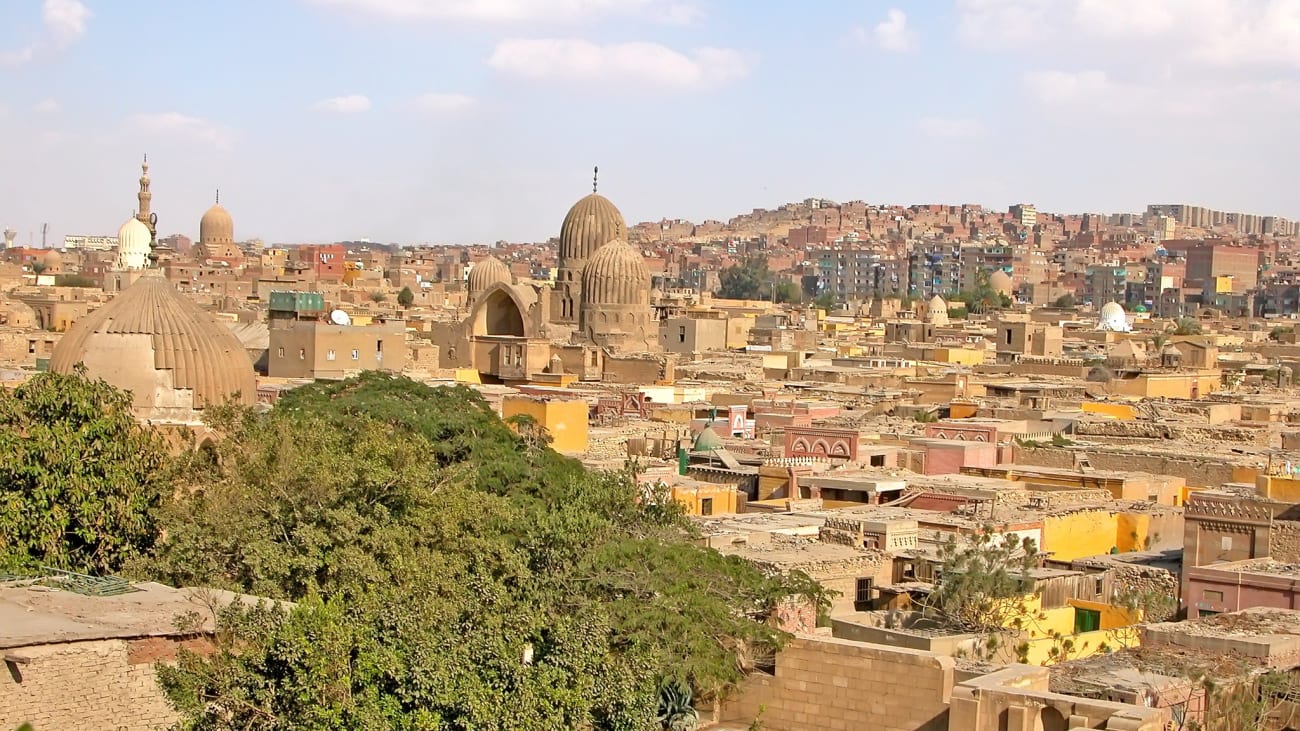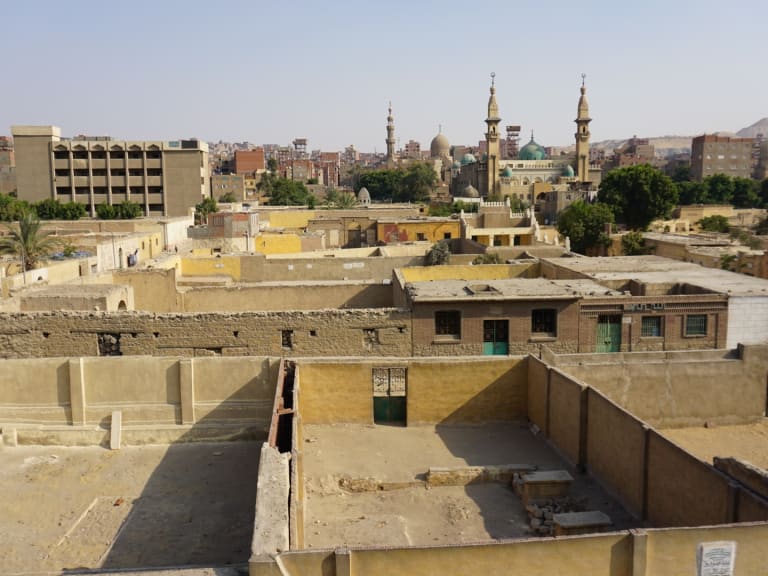Things to Do in City of the Dead (Cairo)
The ornate domes, the views from the minarets and the strolls through the historic streets of Cairo's City of the Dead are unparalleled.

City of the Dead, Cairo | ©Dennis Jarvis
The City of the Dead is an Arab necropolis located in southeastern Cairo. As it has a network of tombs and mausoleums, it is known as "el'arafa" meaning "the cemetery". Along with a tour of the Pyramids of Giza, the City of the Dead is one of the places you must see during your stay in Cairo.
You can opt for a quick taxi ride from the city centre to the Qait Beh Mosque, the price is approximately 4 euros, an excellent starting point for your journey through the City of the Dead. The Qur'anic calligraphy and Arabic divine symbols inside the complex are inspiring. If you have any extra change in your pocket I would recommend paying a tip to the caretaker so that you can climb the minaret. The views from the minaret are unrivalled in Cairo.
1. Guided Tour of the City of the Dead

Stroll through the streets of the City of the Dead in the company of a qualified Egyptologist guide as you head north to see the highlights of this immense necropolis. The advantage of opting for a tour is that you can get around in comfort with a private transfer from your hotel to the City of the Dead and back (air-conditioned minivan transport).
Besides, being a less urban area, you will appreciate being accompanied by someone who knows the place perfectly. The tours cost approximately 35 euros and last an average of 4 hours.
This necropolis has become as popular as any other major destination in the Egyptian capital, so don't be afraid to ask about every detail and wander freely from the start of the tour to its conclusion. However, *it is advisable to go during daylight hours, to appreciate every nook and cranny of the necropolis in detail.
On these tours of the City of the Dead you will explore the small squares where children play football, close to historic tombs. You will also cross the narrow corridors leading to the different mosques. Believe me, the atmosphere in these narrow streets is iconic.
There are also many events organised in this area and you can check the following Facebook page for upcoming events.
2. Pay homage to the heroic Egyptians at the Northern Cemeteries

Don't forget to pay tribute to the Egyptians who fell in the 1967 War against Israel, just south of the Amir Qurqumas Mosque. There are many untidy and heroically styled gravestones here as a way of acknowledging the brave Egyptians. This area tends to have more tourists and locals, so you can also take the opportunity to ask questions and have a collective experience.
If circumstances and time permit, take the time to talk to the locals, many of whom speak decent English. You are sure to hear inspiring stories of family and patriotic love. You can also meet the people who work in the City of the Dead, full of shops, handicraft workshops.... After all, it is the impressions and memories of the people that you will carry with you everywhere. Most of the locals are very fluent in English, especially the younger ones.
3. Attend a concert or cultural event

When there's an event or concert at MASQ (Maqad of Sultan Qaitbai; a free entertainment association with theatrical and dance performances), the place fills up with Egyptian hipsters, artistic expats and architecture enthusiasts.
Just as the spacious reception hall once welcomed Mamluk royalty, today it welcomes everything from modern art exhibitions to lively musical concerts, and these cultural events are often regulated by MASQ. Check MASQ 's Facebook page for more information.
If you go to Cairo in November (early) I recommend D-CAF, the annual contemporary art festival, as it hosts fairs focusing on neighbourhood artisans. There are also presentations of contemporary artists' work, walking tours and music festivals.
These events play a crucial role in bringing historic buildings into practical use, ensuring that the structures remain in good condition and are not abandoned. Residents also benefit from social development programmes. And it all helps to slowly remove the stigma surrounding the City of the Dead, where many tourists are afraid to visit.
4. Visit the Munkalibugha al-Fakhri Mausoleum

The once glorious Mamluk tomb, built in the 1340s, shows touches of magnificence and glorious detail despite some crumbling walls.
The mausoleum once served as a two-storey residence with beautiful inscriptions on the stairs and ceiling. While it is certainly not in the best condition it could be in, it still displays Ottoman tombstones, colourful tiles and writings on stone.
5. Explore street art and murals

There is more to the City of the Dead than the historical monuments of its magnificent past. There is also some wonderful graffiti.
Murals burst with life from unexpected corners to give the neighbourhood joy and colour. There is a smiling mouse with the word ahlan (welcome) painted on a corner of the Salah Salem Highway that draws you into the mysterious streets of the City of the Dead.
In and around the Maq'ad, and further down Souq Street, there are more ingenious depictions of this mouse: holding a cat by the chain or running away from an unravelling mummy. The mouse is an original creation of the Polish artist Franek Mysza, who first came to the City of the Dead for an art project.
In the City of the Dead, Mysza began painting some private houses (with the permission of the owners). Many residents were sceptical at first, but once the mouse started to gain attention, others wanted to join the artistic trend.
6. Walk along Souq Street

This street has several carved domes on some buildings recalling the glorious era of Qaitbey's reign. There is the Mysza mouse in some of the side streets. And there is a mural depicting an ancient Egyptian king next to graffiti of football star Mohammed Salah. The narrow street opens onto a wider square with a bright vegetable market and a kiosk laden with refreshments.
Walk down El Souq Street and you'll see a carved archway with the typical intricacy of Mamluk architecture that reaches its peak in the modern flat blocks.
There is a mural of the Kaaba decorating one house, showing that its residents have been to Mecca. Potted plants line the doorways, and there are a couple of small shisha cafés. You can also spot Mamluk domes or tombstones from the street itself.
7. Visit the Faraj ibn Barquq Complex

Don't forget to visit the Faraj ibn Barquq complex with its beautiful mosque and leafy courtyard.The security guard can guide you or you can go inside and walk around on your own.
The vast courtyard has two chevron-carved stone domes. One of the largest monuments of the Mamluk period in Burgi, the complex dates from AD 1400-1411. Sultan Faraj built the complex as a tribute to his father, Sultan Barquq.
The complex marks one of the first signs of urbanisation in a Cairo that was then only a vast desert. The complex also includes baths, grain mills and water wheels.
8. Buy some glass

The City of the Dead is known for its glassblowers, and here you'll find a few workshops selling everything from vases and drinking cups to Cairo Christmas ornaments. It's worth noting that these craftsmen are very flexible and professional when it comes to making creations, so if you can get them to grasp your idea, it's only a matter of minutes before you'll see that idea come to fruition.
9. Spend Ramadan in the City of the Dead

Ramadan, with its festivities filled with lights and food, is an *incredible time to explore this necropolis **. A **variety of events are often organised during the holidays, from Egyptian folk dances, to tanoura (a traditional dance) performances and theatrical performances.
If you're looking to enjoy the nightlife in the Egyptian capital and, in particular, the City of the Dead, you'll want to consider coming during Ramadan.
10. Amir Qurqumas Mosque and the Sultan Inal Funerary Complex

If your appetite for Mamluk architecture has not been satisfied on your stroll through the streets of the City of the Dead, head further north to enjoy two of the most lauded buildings: the Amir Qurqumas Mosque and the Sultan Inal Funerary Complex.
The beautiful stone-carved arabesque design and being able to discover the site on your own are part of the same experience. These complexes not only had mosques and tombs associated with them, but also had markets, residences and construction workshops for the maintenance of the architectural structure, details that you will appreciate as soon as you arrive in the area.
What Cairo's City of the Dead looks like

There were always people living in this City of the Dead. And nowadays, there is no longer much difference between this area and other districts of Cairo. There are high-rise flat blocks, vegetable markets, schools and cafes.
However, there is an atmosphere in the City of the Dead that you won't find anywhere else. It is a quiet place compared to most of Cairo. The narrow unpaved streets mean less traffic and noise.
And although some companies offer walking tours, the City of the Dead is still largely unexplored by tourists. There are also no souvenir shops or pushy vendors promising great bargains, yet it's full of treasures you won't find in the city's modern suburbs. Some are lovingly restored, while others lie in heartbreaking neglect.
The area contains some 30 Mamluk monuments, these being UNESCO heritage sites. It also includes many 19th century Ottoman tombs of great historical value.
The City of the Dead is an unspoilt part of the city. It's also a place that defies stereotypes- there is a clear mix of intellectuals, from university graduates or people who speak English very fluently to people who are illiterate or have never had a school education.
A Brief History of the Mysterious City of the Dead

The City of the Dead was founded by Amr ibn al-As, who led the Arab conquest of Egypt in AD 642. Initially the necropolis was only inhabited by Sufi mystics. The Fatimid Caliphate saw the City of the Dead as a place for pilgrimages. Later Mamluk sultans held military parades, religious celebrations and processions, while building their palaces on the main roads of the cemetery. During the Ottoman era, the necropolis was dotted with Sufi colleges and madrasas.
